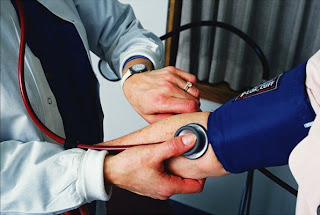Almost everyone knows that a healthy diet is closely related to disease prevention. But, do you know if your food choices can also reduce blood pressure? Besides losing weight, if you are obese, diet is a safe and effective in lowering blood pressure. With the change dietary habits is quite simple, including counting calories and watching portions, you can prevent high blood pressure, one of the factors that are proven to increase the risk of heart disease.
Weight and blood pressure
People who are overweight or obese tend to have hypertension. However, studies have shown, can be lowered blood pressure by losing weight.
Losing weight also while reducing the use of drugs that are used to control blood pressure.If you are overweight, consult with your doctor to determine the right diet. Surely the best way is to burn more heat through physical activity. Regular exercise (at least 30 minutes a day) can help lower blood pressure and strengthen the heart.
Some people do not realize the amount of calories consumed. Therefore, the best way to know the amount of calories you is by making a written record of your daily intake. Write down the foods you eat, including portion. That way, you can see and control more clearly.
Diet and blood pressure
Many foods that affect blood pressure. Studies show a diet high in sodium can increase blood pressure. Based on these studies, the less sodium you consume, the better your blood pressure, even if you use the controller medication blood pressure.
The study also found, potassium, magnesium, and fiber also affects blood pressure. Fruits and vegetables rich in potassium, magnesium and fiber and low in sodium. In addition, nuts, grains, legumes, low-fat meat, poultry fiber are also rich in magnesium.
Does the DASH diet can lower high blood pressure?
Dietary Approaches to Stop Hypertension (DASH) is a study that looked at the impact of different dietary patterns on blood pressure reduction. The researcher, as quoted by WebMD site found that those who implement the DASH diet decreased blood pressure in just a few weeks.
DASH diet that recommends the use of only 1,500 milligrams of sodium (about 2/3 teaspoon of salt) a day, also has a positive effect in lowering blood pressure. In addition, women who follow this diet for several years also decreased risk of coronary artery heart disease and stroke.
DASH diet
DASH diet rich in fruits, vegetables, whole grains, fish, poultry, nuts and legumes, and low in dairy products. These foods are rich in essential nutrients like potassium, magnesium, calcium, fiber, and protein. Compared to other diets, this diet also contains less sodium or salt, sugar, sweetened beverages furnished, fat, red meat and processed meat.
To start your DASH diet, the following food groups and their proportion (based on 2000 calorie a day diet):
Grains: 7-8 servings per day (the size of servings: 1 slice bread, 1/2 cup pasta or rice, 1 ounce dry cereal)
Vegetables: 4-5 servings per day (the size of servings: 1 cup raw leafy greens, 1/2 cup cooked vegetables)
Fruits: 4-5 servings per day (serving size: 1 medium fruit, 1/2 cup fresh or canned fruit, 1/4 cup dried fruit, 6 ounces of fruit juice)
Products of low or nonfat milk: 2-3 servings per day (serving size: 8 ounces milk, 1 cup yogurt, 1.5 ounces of cheese)
Low-fat meat, poultry, fish: 2 drinks or less a day (serving size: 3 ounces cooked meat, poultry, or fish)
Nuts, grains, and legumes: 4-5 servings per week (the size of servings: 1/3 cup nuts, 2 tablespoons of seeds, 1/2 cup cooked dried soybeans)
Fats and oils: 2-3 servings per day (servings size: 1 teaspoon vegetable oil or soft margarine, 1 tablespoon low-fat mayonnaise, 2 tablespoons salad dressing)
 Sweeteners: try to consume less than 5 servings per week (the size of servings: 1 tablespoon sugar or jelly/h)
Sweeteners: try to consume less than 5 servings per week (the size of servings: 1 tablespoon sugar or jelly/h) Try reducing salt intake to just 2,300 milligrams (about 1 teaspoon) per day. Once the body has become accustomed to low-sodium diet, you can reduce salt intake to just 1,500 milligrams (2/3 teaspoon) a day.


No comments:
Post a Comment